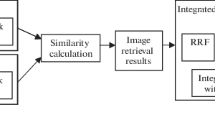Abstract
In many Web image retrieval applications, adapting the retrieval results according to some model of the user is a desired feature as the returned images can be made specifically relevant to a user’s needs. Making retrieval user-adaptive faces several practical challenges, including the ambiguity of user query, the lack of user-adaptive training data, and lack of proper mechanisms for supporting adaptive learning. To address some of these challenges, we propose a hybrid learning strategy that fuses knowledge from both pointwise and pairwise training data into one framework for attribute-based, user-adaptive image retrieval. An online learning algorithm is developed for updating the ranking performance based on user feedback. The framework is also derived into a kernel form allowing easy application of kernel techniques. We use both synthetic and real-world datasets to evaluate the performance of the proposed algorithm. Comparison with other state-of-the-art approaches suggests that our method achieves obvious performance gains over ranking and zero-shot learning. Further, our online learning algorithm was found to be able to deliver much better performance than batch learning, given the same elapsed running time.







Similar content being viewed by others
References
Berg TL, Berg AC, Shih J (2010) Automatic attribute discovery and characterization from noisy web data. In: Proc. of ECCV’10, Springer-Verlag, Berlin, pp 663–676. http://dl.acm.org/citation.cfm?id=1886063.1886114
Burges C, Shaked T, Renshaw E, Lazier A, Deeds M, Hamilton N, Hullender G (2005) Learning to rank using gradient descent. In: Proc. of ICML ’05, pp 89–96. ACM. doi:10.1145/1102351.1102363
Cao Y, Xu J, Liu TY, Li H, Huang Y, Hon HW (2006) Adapting ranking svm to document retrieval. In: Proc. of SIGIR ’06, ACM, pp 186–193. doi:10.1145/1148170.1148205
Chen L, Zhang P, Li B (2014) Instructive video retrieval based on hybrid ranking and attribute learning: a case study on surgical skill training. In: Proceedings of the ACM International Conference on Multimedia, MM ’14, ACM, New York, pp 1045–1048. doi:10.1145/2647868.2655050
Chen L, Zhang P, Li B (2015) Fusing pointwise and pairwise labels for supporting user-adaptive image retrieval. In: Proceedings of the 5th ACM on International Conference on Multimedia Retrieval, ICMR ’15, ACM, New York, pp 67–74. doi:10.1145/2671188.2749358
Chen L, Zhang Q, Li B (2014) Predicting multiple attributes via relative multi-task learning. In: Proc. of CVPR ’14, pp 1027–1034
Elahi N, Karlsen R, Holsbø EJ (2013) Personalized photo recommendation by leveraging user modeling on social network. In: Proc. of IIWAS ’13, ACM, pp 68:68–68:71. doi:10.1145/2539150.2539232
Farhadi A, Endres I, Hoiem D, Forsyth D (2009) Describing objects by their attributes. In: Proc. of CVPR ’09, pp 1778–1785. doi:10.1109/CVPR.2009.5206772
Freund Y, Iyer R, Schapire RE, Singer Y (2003) An efficient boosting algorithm for combining preferences. J Mach Learn Res 4:933–969. http://dl.acm.org/citation.cfm?id=945365.964285
Joachims T (2002) Optimizing search engines using clickthrough data. In: Proc. of KDD ’02, pp 133–142. ACM. doi:10.1145/775047.775067
Kimeldorf G, Wahba G (1971) Some results on tchebycheffian spline functions. J Math Anal Appl 33(1):82–95. doi:10.1016/0022-247X(71)90184-3. http://www.sciencedirect.com/science/article/pii/0022247X71901843
Kovashka A, Grauman K (2013) Attribute adaptation for personalized image search. In: Proc. of ICCV ’13, pp 3432–3439. doi:10.1109/ICCV.2013.426
Kovashka A, Parikh D, Grauman K (2012) Whittlesearch: Image search with relative attribute feedback. In: Proc. of CVPR’12, pp 2973–2980. doi:10.1109/CVPR.2012.6248026
Kumar N, Belhumeur P, Nayar S (2008) Facetracer: A search engine for large collections of images with faces. In: Proc. of ECCV ’08, Springer-Verlag, Berlin, pp 340–353
Kumar N, Berg A, Belhumeur P, Nayar S (2009) Attribute and simile classifiers for face verification. In: Proc. of CVPR ’09, pp 365–372. doi:10.1109/ICCV.2009.5459250
Lampert C, Nickisch H, Harmeling S (2009) Learning to detect unseen object classes by between-class attribute transfer. In: Proc. of CVPR ’09, pp 951–958. doi:10.1109/CVPR.2009.5206594
Li P, Wu Q, Burges CJ (2008) Mcrank: Learning to rank using multiple classification and gradient boosting. In: Proc. of NIPS ’08, Curran Associates, Inc., pp 897–904. http://papers.nips.cc/paper/3270-mcrank-learning-to-rank-using-multiple-classification-and-gradient-boosting.pdf
Moon T, Smola A, Chang Y, Zheng Z (2010) Intervalrank: Isotonic regression with listwise and pairwise constraints. In: WSDM. doi:10.1145/1718487.1718507
Oliva A, Torralba A (2001) Modeling the shape of the scene: a holistic representation of the spatial envelope. Int J Comput Vision 42(3):145–175. doi:10.1023/A:1011139631724
Parikh D, Grauman K (2011) Relative attributes. In: Proc. of ICCV ’11, pp 503–510. doi:10.1109/ICCV.2011.6126281
Renjifo C, Carmen C (2012) The discounted cumulative margin penalty: rank-learning with a list-wise loss and pair-wise margins. In: MLSP. doi:10.1109/MLSP.2012.6349807
Sang J, Xu C, Lu D (2012) Learn to personalized image search from the photo sharing websites. Multim IEEE Trans 14(4):963–974. doi:10.1109/TMM.2011.2181344
Sculley D (2010) Combined regression and ranking. In: Proc. of SIGKDD’10, ACM, New York, pp 979–988. doi:10.1145/1835804.1835928
Shalev-Shwartz S, Singer Y, Srebro N (2007) Pegasos: Primal estimated sub-gradient solver for svm. In: Proc. of ICML ’07, ACM, pp 807–814. doi:10.1145/1273496.1273598
Shashua A, Levin A (2003) Ranking with large margin principle: two approaches. In: Proc. of NIPS ’03, pp 961–968. MIT Press. http://papers.nips.cc/paper/2269-ranking-with-large-margin-principle-two-approaches.pdf
Shen X, Tan B, Zhai C (2005) Context-sensitive information retrieval using implicit feedback. In: Proc. of SIGIR ’05, ACM, pp 43–50. doi:10.1145/1076034.1076045
Song Y, Wang H, He X (2014) Adapting deep ranknet for personalized search. In: Proc. of WSDM ’14, ACM, pp 83–92.doi:10.1145/2556195.2556234
Sontag D, Collins-Thompson K, Bennett PN, White RW, Dumais S, Billerbeck B (2012) Probabilistic models for personalizing web search. In: Proc. of WSDM ’12, ACM, pp 433–442. doi:10.1145/2124295.2124348
Tsai MF, Liu TY, Qin T, Chen HH, Ma WY (2007) Frank: A ranking method with fidelity loss. In: Proc. of SIGIR ’07, ACM, pp 383–390. doi:10.1145/1277741.1277808
Vaquero DA, Feris RS, Tran D, Brown L, Hampapur A, Turk M (2009) Attribute-based people search in surveillance environments. In: Applications of computer vision (WACV), Workshop on Dec 2009, pp 1–8. doi:10.1109/WACV.2009.5403131
Wang H, He X, Chang MW, Song Y, White RW, Chu W (2013) Personalized ranking model adaptation for web search. In: Proc. of SIGIR ’13, ACM, pp 323–332. doi:10.1145/2484028.2484068
Wang Y, Mori G (2010) A discriminative latent model of object classes and attributes. In: Proc. of ECCV’10, Springer-Verlag, pp 155–168. http://dl.acm.org/citation.cfm?id=1888150.1888163
White RW, Bennett PN, Dumais ST (2010) Predicting short-term interests using activity-based search context. In: Proc. of CIKM ’10, ACM, pp 1009–1018. doi:10.1145/1871437.1871565
Zhang H, Zha ZJ, Yan S, Bian J, Chua TS (2012) Attribute feedback. In: Proceedings of the 20th ACM international conference on multimedia, MM ’12, ACM, New York, pp. 79–88. doi:10.1145/2393347.2393365
Zhang H, Zha ZJ, Yang Y, Yan S, Gao Y, Chua TS (2013) Attribute-augmented semantic hierarchy: towards bridging semantic gap and intention gap in image retrieval. In: Proceedings of the 21st ACM international conference on multimedia, MM ’13, ACM, New York, pp 33–42. doi:10.1145/2502081.2502093
Acknowledgments
The work was supported in part by a grant from the Army Research Office (ARO). Any opinions expressed in this material are those of the authors and do not necessarily reflect the views of the ARO.
Author information
Authors and Affiliations
Corresponding author
Rights and permissions
About this article
Cite this article
Chen, L., Zhang, P. & Li, B. User-adaptive image retrieval via fusing pointwise and pairwise labels. Int J Multimed Info Retr 5, 19–33 (2016). https://doi.org/10.1007/s13735-015-0092-1
Received:
Accepted:
Published:
Issue Date:
DOI: https://doi.org/10.1007/s13735-015-0092-1




